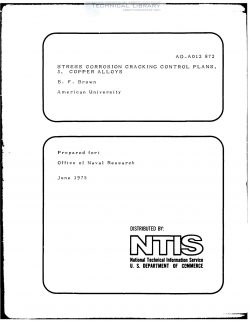NTIS-AD-A-012-872
- Version
- 183 Downloads
- 1.42 MB File Size
- 1 File Count
- March 7, 2017 Create Date
- March 7, 2017 Last Updated
Office of Naval Research - Stress Corrosion Cracking Control Plans - III - Copper Alloys

ALLOY NOMENCLATURE mhe atomic arrangement in crystals of pare copper is face—centered cubic, and as long as this arrangement is retained in copper alloys, they are designated alpha alloys , such as alpha brass. If a brass contains more than about 3" zinc, grains of a second phase termed beta appear among the alpha grains. The beta phase has the atoms arranged in a body—centered cubic lattice. Brasses con— taining both phases are termed alpha—beta brasses. Above about 408 zinc the alloys consist of all beta grains and are termed beta brasses. Beta brass alloys are rare in commerce, but a few are produced in Europe. Copper alloys are not strengthened by heat treatment, with few exceptions, notably beryllium copper. But they are commonly strengthened by cold working. The term bronze was once reserved for copper alloys in which the principal alloy addition was tin, but the term has been debased to the point that its use serves little more than to exclude the near ly ail—copper alloys and the nearly pure binary copper—zinc alloys (hr-asses} .
A principal environment causing SCC in copper alloys , although not the only one, IS generally believed to involve arnrnoniacal compounds. SCC in the copper/ammoniac-l system has often been termed "season cracking" by leading authorities but there is a lack of unanimity in defining this term by various authors and nomenclature committees. Therefore to avoid any possible confusion the term "amnoniacal SCC" will be used here instead, though even so it should be understood that the word "ammoniacaln is a convenience intended to include amines and all other species which can react with copper to produce the cupric—arnrnonium complex ion or perhapa btructuraily similar complexes. If -one learns how to avoid ammoniacal SCC, a large proportion of the practical SCC threat to copper alloys will have been prevented. Not only is it considered a principal SCC hazard to copper alloys, but it is also the SCC system for which we have the most intercomparable laboratory data and field experience by far. We Will there Eore treat ammoniacal SCC as the principal topic of this chapter, thereafter treating the Other alloy/environment systems which do not fit into the major group. These other systems, though they have been responsible for fewer SCC failures than ammoniacal SCC, be extremely troublesome, as will be seen. historically can nevertheless It should be especially noted that recent studies with copper Sulfate
| File | Action |
|---|---|
| NTIS-AD-A-012-872 Stress Corrosion Cracking Control Plans - III - Copper Alloys.pdf | Download |

Comment On This Post